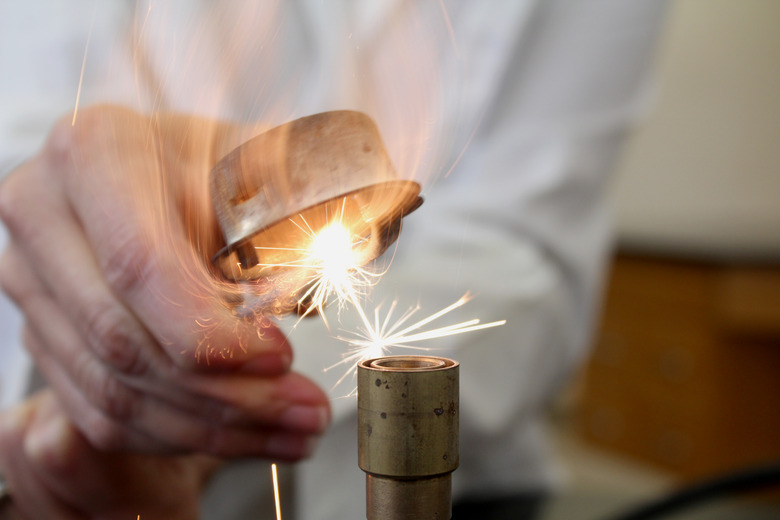Parts Of A Bunsen Burner & Their Functions
One of the first pieces of equipment a science student encounters in the lab is the Bunsen burner. Typically, it is an exciting day as everyone learns how to set up, spark and control the flames. But things can definitely go wrong, so having a solid base of information before getting to the lab bench is important.
A Bunsen burner is one of the most common pieces of equipment in the laboratory, and many scientists use it in their work. It is a special burner, which uses flammable natural gases such as methane, or petroleum gases such as propane, to burn and works similarly to a gas stove. However, it has an air supply controlled by an adjustable hole, which is not the case with the gas stove. It also produces a clean and hot flame.
History of the Bunsen Burner
History of the Bunsen Burner
Who is responsible for the creation of the Bunsen burner? Well, the name may give you a clue, but it is actually the result of progressive discoveries by different scientists. A gas engineer, R. W. Elsner, was the first inventor of the ancient form of the burner. Michael Faraday then improved the design of the burner. This was before Robert Wilhelm Bunsen, a German chemist, developed the modern burner and popularized it in the late 1800s.
Parts and Their Functions
Parts and Their Functions
Handling a Bunsen burner is one of the most thrilling experiences for a new student in a laboratory. However, one should be familiar with the different parts of a burner to handle it safely and understand how it works.
An efficient Bunsen burner is purely metallic (except the gas tubing) and has five main parts:
1\. **Barrel or stack:** It is approximately 5 inches long to raise the flame to a suitable height for heating. This is where gas and air mix for combustion.
2\. **Collar:** It is a small disk at the bottom of the barrel that adjusts to control the amount of the air entering the barrel. It has an air hole to allow entry of air into the barrel. On some models, scientists can reduce the flow of air by tightening the connection between the barrel and the base.
3\. **Jet:** Allows the gas to enter the barrel from tubing connected to the fuel source and mix with air from the air hole before combustion.
4\. **Base:** It is the burner's support and therefore relatively wide and heavy.
5\. **Gas tap or valve:** It contains and controls the amount of gas relayed to the burner.
Operation of a Bunsen Burner
Operation of a Bunsen Burner
The first thing a scientist does is connect the Bunsen burner to a source of fuel. It produces two types of flames depending on whether the air hole is open and the amount of air entering the barrel. With a mostly closed air hole, a luminous flame appears. This flame is yellow and wavy.
With the air hole set to open, oxygen in the air that enters the barrel reacts with the incoming gas in a ratio of one to three to produce a blue and steady, non-luminous flame. This flame is hotter and preferred for heating in the laboratory because it is easier to control than a wavy, luminous flame. This flame also does not produce soot, which is another reason for its preferred use.
The amount of air entering the barrel also determines the size of the flame and the heat produced. The more oxygen is in the air, the larger the size of the flame, and the more the heat dissipates. However, when excess gas enters into the barrel, it can extinguish the flame.
Uses of the Bunsen Burner
Uses of the Bunsen Burner
The Bunsen burner has a variety of uses in different fields. For instance, engineers may use the burner flame to test the effect of heat on various elements and the linear expansivity of different metals. Chemists, on the other hand, may use it to remove water from hydrated chemicals or to accelerate and trigger chemical reactions. Biologists use the burner flame to sterilize tools used to handle bacteria and other sensitive microorganisms.
Safety Tips
Safety Tips
A Bunsen burner can be a dangerous piece of equipment when mishandled. Therefore, for a safe and successful experiment with the burner in the laboratory, scientists must adhere to certain safety measures.
- Always turn off the burner after use. A hot,
blue flame is not always visible, so it is imperative that you remember to turn it off and avoid accidents.
- Always make sure that flammable liquids and
combustible materials are not near the burner to avoid the risk of unwanted fires and explosions.
- When lighting the gas, students should have their
strikers ready to avoid excess gas leakage that might lead to an explosion.
- Once you are done with the Bunsen burner, it is critical for safety reasons to turn off the main gas valve to avoid gas leaks.
- Lab workers should tie back any loose or long
hair. Tuck in shoelaces to avoid falls and remove any dangling jewelry that could come into contact with the flame.
- Lastly, the burner should cool completely after
use before any further handling.
The Bunsen burner is a pivotal tool in carrying out different tasks in the world of science. Taking the time to understand how it works and how to use it safely is critical to any future scientist's success in the lab.
Cite This Article
MLA
Cook, Amanda. "Parts Of A Bunsen Burner & Their Functions" sciencing.com, https://www.sciencing.com/parts-bunsen-burner-functions-7172302/. 26 April 2018.
APA
Cook, Amanda. (2018, April 26). Parts Of A Bunsen Burner & Their Functions. sciencing.com. Retrieved from https://www.sciencing.com/parts-bunsen-burner-functions-7172302/
Chicago
Cook, Amanda. Parts Of A Bunsen Burner & Their Functions last modified August 30, 2022. https://www.sciencing.com/parts-bunsen-burner-functions-7172302/
